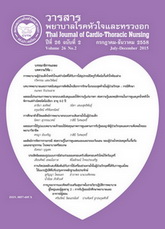การศึกษาตัวชี้วัดผลลัพธ์การพยาบาลระบบทางเดินหายใจในผู้ป่วยเด็ก
Keywords:
ตัวชี้วัด, ผลลัพธ์ทางการพยาบาล, การพยาบาลทางเดินหายใจในเด็ก, indicators, nursing outcomes, pediatric respiratory careAbstract
การวิจัยนี้เป็นงานวิจัยเชิงบรรยายแบบ Delphi technique เพื่อศึกษาตัวชี้วัดผลลัพธ์การพยาบาลระบบทางเดินหายใจในผู้ป่วยเด็ก ในกลุ่มผู้เชี่ยวชาญด้านผู้ป่วยเด็กระบบทางเดินหายใจ จำนวน 20 คน แบ่งเป็น 4 กลุ่ม ได้แก่ 1) ผู้บริหารทางการพยาบาล 5 คน 2) พยาบาลปฏิบัติการขั้นสูง 6 คน 3) นักวิชาการทางการพยาบาล 5 คน และ 4) แพทย์เฉพาะทาง 4 คน เครื่องมือที่ใช้ในการวิจัยประกอบด้วย แบบสอบถาม 3 รอบ รอบที่ 1เป็นแบบสัมภาษณ์กึ่งโครงสร้าง เพื่อค้นหาตัวชี้วัด รอบที่ 2) วิเคราะห์ข้อมูลที่ได้จากรอบที่ 1 สร้างแบบสอบถามมาตราประมาณค่า ให้ผู้เชี่ยวชาญ ให้ความสำคัญของตัวชี้วัด และรอบที่ 3 แสดงข้อมูลป้อนกลับ ได้แก่ ค่า มัธยฐานและค่าพิสัยระหว่าง ควอไทล์ ในแต่ละข้อรายการและให้ผู้เชี่ยวชาญยืนยันคำตอบ
ผลการวิจัยพบว่า กลุ่มผู้เชี่ยวชาญเห็นสอดคล้องกันว่า ตัวชี้วัดผลลัพธ์การพยาบาลระบบทางเดินหายใจในผู้ป่วยเด็ก ควรประกอบด้วย 5 ด้าน 44 ตัวชี้วัด ได้แก่ 1) ด้านความปลอดภัยของระบบทางเดินหายใจ (20ตัวชี้วัด) 2) ด้านความสุขสบายทางด้านร่างกาย จิตสังคม จิตวิญญาณ และสิ่งแวดล้อม (6 ตัวชี้วัด) 3) ด้านความสามารถของครอบครัวในการดูแลต่อเนื่อง (4 ตัวชี้วัด) 4) ด้านความสามารถในการเผชิญปัญหาของครอบครัว (7 ตัวชี้วัด) 5) ด้านความสมดุล สารน้ำ เกลือแร่ และการได้รับสารอาหารเพียงพอ (7 ตัวชี้วัด) ตัวชี้วัดทุกตัวมีระดับความสำคัญมากที่สุด (Med = 4.67-4.74 I.R. =0.15-0.31)
ผลการศึกษาครั้งนี้ สามารถนำไปเป็นเครื่องมือในการประเมินผลลัพธ์การพยาบาลผู้ป่วยเด็กระบบทางเดินหายใจต่อไป
A study of nursing outcomes indicators for pediatric respiratory care
This research was a descriptive research using the Delphi technique. The purpose was to study nursing outcomes indicators for pediatric respiratory care from 20 experts in pediatric respiratory care which were divided into 4 groups including 1) 5 nursing managers, 2) 6 Advance Practice Nurse, 3) 5 nursing instructors and 4) 4 physicians. The questionnaires used for the instrument of this research were developed in 3 stages. First, by using semi-open ended form of interview, the experts were asked to identify the nursing outcomes indicators for pediatric respiratory care. Second, the data received from the first stage was analyzed to develop the rating scale questionnaires which each sequence would be possibly ranked by prior panel of the experts. Third, the median and interquartile range was used to analyze and correct the data in order to re-design the rating scale questionnaire. Finally, the participants had to finish the completed questionnaires, rating scale, again.
The results revealed that the experts’ opinion had a consensus on nursing outcomes indicators for pediatric respiratory care should be 5 domains and 44 indicators: 1) safety of respiratory system (20 indicator), 2) comfort status: physical, sociocultural, psychospiritual and environment (6 indicators), 3) family’s ability in continuity of care (4 indicators), 4) family coping (7 indicators), 5) fluid, electrolyte balance and sufficient nutrients (7 indicators). All of these indicators were in a very important level (Med = 4.67-4.74, I.R. = 0.15-0.31).
The results of this study can be used as a measurement of nursing outcomes indicators for pediatric respiratory care.
Downloads
How to Cite
Issue
Section
License
บทความนี้ยังไม่เคยตีพิมพ์หรืออยู่ในระหว่างส่งไปตีพิมพ์ในวารสารอื่น ๆ มาก่อน และกองบรรณาธิการขอสงวนสิทธิ์ในการตรวจทาน และแก้ไขต้นฉบับตามเกณฑ์ของวารสาร ในกรณีที่เรื่องของท่านได้ได้รับการตีพิมพ์ในวารสารฉบับนี้ถือว่าเป็น ลิขสิทธิ์ของวารสารพยาบาลโรคหัวใจและทรวงอก






